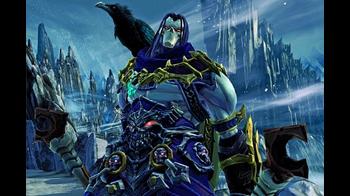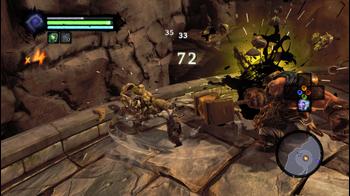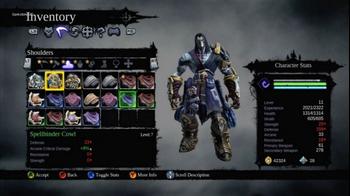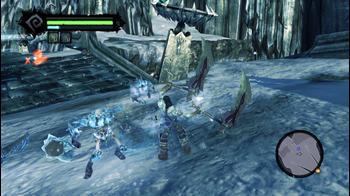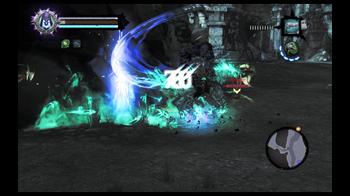
Darksiders II Review
Although the label “II” implies that Darksiders II is a sequel, in many ways it can be considered a step back. However, with every step back the game does take, it takes two dozen steps forward pushing the franchise, and possibly this hybrid genre, to a new frontier. Darksiders II is a mix of action, adventure, RPG, and loot farming all packed into a cohesive and compelling game that can easily last over a dozen hours. Even if you’re not a fan of action or adventure, there are other enticing aspects of the game that will draw you in and hold your attention as you make your journey with Death.
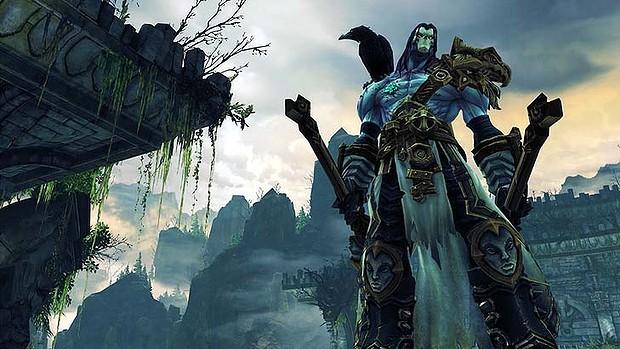
While the original Darksiders focused on one of the horsemen War, in its sequel you take control of his all-powerful brother Death. Surprisingly, the story doesn’t continue from where the original left off, rather it shows Death’s journey as War faces his own problems. Seeing that War was falsely accused of his crimes of starting the Apocalypse on Earth, Death seeks to clear his brother’s name by reviving humankind. It’s a simple premise that keeps the journey going from beginning to end and Death deviates little from his divine path.
Along the way Death will encounter the Crowfather - who he seeks assistance from - but has to come face to face with his past: the destruction of the Nephilim, his own race. Although he says he is not filled with guilt, he is heavily accused of it by the Crowfather. In addition to this guilt, Death must face a mysterious force known as Corruption that destroys and corrupts anything it touches. And so Death begins his journey to redeem himself, his brother, and destroy whatever corruption stands in his way.
Death’s journey takes him to various places which allow him to meet various people. The cast of the game is very diverse to say the least and each character never overstays his or her welcome. However, whatever screen time they do spend is so little of importance, it’s hard to care about the characters that you come in contact with or even the protagonist, Death, himself. This is all due to how the narrative is structured and created. Death is always on the quest to revive humanity but is ordered by people to complete certain tasks to point him the right way. As a result at many times Death feels like an obedient lap dog that listens to the various whims of the Darksiders universe. In addition, the people who give Death orders simply exist to give Death direction. There really isn’t any depth to the characters and as a result hurts the overall narrative.
However, the most disappointing aspect of the story is perhaps the antagonist of the game. There is little to no background about the villain and Death’s opposing forces. Being an extremely flat character with almost no precedence to his presence, the final showdown has almost no meaning, and it seems Death cares little about it as well. Due to the non-chalant attitude that the story takes, it becomes difficult for players to care about it. One fetch quest leads to another and one task ends to start a new one. This perpetual narrative cycle hinders the game’s story and it makes it feel like you made no actual progress since the beginning of the game until you reach the story’s final moments.
Despite the narrative problems that Darksiders II faces, the gameplay is strong on all fronts. Combat is the star in the game as it completely revamps the original’s system into something more akin to Devil May Cry 3. While it may not be technical as the aforementioned title, it’s still extremely deep and requires a lot of thinking to master the system. Death has two primary weapons that he can hold at a given time. One is his scythe, which cannot be switched out, and the second can either be a fast attacking set of fists or a hammer. Each weapon offers their unique gameplay advantages. While the scythe has a great amount of moves at your disposal, it comes nowhere near your fists in terms of speed. On the other hand neither of these two weapons can match the power of the hammer. Each has its draws since the hammer is slower and the fist weapons tend to be weaker. As a result, choosing your second weapon and trying to match that with the scythes is quintessential to becoming a combat master.
Each weapon has its own designated button and switching weapons in between attacks greatly reward the player as it gives you more stylish moves as well as devastating blows. In addition to the two primary weapons, players can invoke special moves that are mapped to four button combinations. These special moves use Wrath - a resource like mana - and unleash insane moves giving you the ability to teleport, summon a vortex, or give you a massive power boost. Just using your weapons won’t help you come out of skirmishes alive, and the game encourages you to mix and match various combat elements to create an efficient way of fighting while pulling off some stylish moves.
The combat is insanely fast paced and the various enemy types force you to adapt new tactics. For instance, a group of small bugs flying around might be easier to handle if you draw out a gun and wipe them out. On the other hand two large mini-boss like enemies might be more manageable if you teleport around to dodge as to avoid getting hit by both. It’s this deep and intricate combat system, and the resources that it gives you, that creates tons of fun as well as a feeling of reward.
While it may seem somewhat obligatory, Death can go into a super form called Reaper mode. This mode allows Death to dish out crazy area-of-effect attacks as well as regenerate his health. It also becomes impossible to die in this mode so if you’re in a pinch on the verge of death - joke intended - then you can just go Reaper on them. It’s an awesome feature and it’s sometimes nice to have it as a failsafe in case something goes wrong.
Behind all of these deep combat mechanics and systems lies a heavily customizable set of systems that players can use to create their own unique Death. Unlike traditional action games, the RPG elements of Darksiders II allow Death to level up and as he grows, gain skill points. These skill points can be used to unlock special moves for Death. There are two separate trees and each come with their own unique fighting style. One is called Harbinger which focuses more on melee and close-ranged attacks. Special moves allow Death to close in on opponents, boost his attack power, or create a powerful vortex of death. On the other side is the Necromacy tree. Here, Death can use moves that summon minions, birds, or otherwise spectral forces to do his bidding while he fights. While you can expand upon the two trees at the same time, it’s not wise as the game tends to encourage you focusing on one, and grow stronger based off of that tree.
The skill tree brings up an interesting way of playing with Death as you are essentially adapting new combat techniques and tactics depending on which side you chose. Additionally, because it’s unwise to undertake both trees at the same time, if you want to play with the remaining side, you’d have to either make a new playthrough or continue on New Game+. As a result, Darksiders II has great longevity as there are new ways to grow Death and new ways to play as him. In the end, you’re going to have a strong character no matter what; the question is how you want him to play.
Combat moves aside, the game has a variety of loot you can collect. As you defeat enemies and explore the world opening new chests Death can get a hold of new weapons or armor. These randomly generated items can deck out Death to all new heights giving that sense of excitement when you come across new equips. Addictive like a loot game in ways, the items possibilities are endless and the items you find are scaled to your level which means you’ll never get something terrible. It’s a neat way to make you truly feel like Death is getting stronger for a game that’s focused on action and adventure.
There are varying types of items. Different color coding indicates rarity and proceeds from white, green, blue, purple, and orange with the latter being the rarest. While the former four have pre-ordained stats and abilities, the orange items do not. Also called Possessed, these items can consume other existing items in your inventory to grow stronger. Not only will its base stats grow but it can obtain the abilities and stats of the items it’s consumed. It’s extremely awesome considering you can farm up certain types of items and feed it to the possessed scythe to get an extremely powerful scythe that steals health with every hit.
The dungeons take the game to new heights. As you undertake tasks or accept new quests, Death may have to travel through a dungeon. These clever little locations are filled with dastardly smart puzzles and excellent level design. It’s never too hard to figure out where to go but never too easy to know what to do. What we get in the end is a perfect balance of handholding but at the same time giving us the freedom to experiment and roam. It’s not hard to get lost and if you ever do get stuck trying to figure out what you’re supposed to do and where to go, you can summon your flying partner Dusk to guide you. Sadly he doesn’t lead you to right place all the time so it can get annoying but most of the times, he is right.
These dungeons never run on for too long and you never get the feeling of dread as a result. It’s hard to find a balance for dungeons when trying to pace them but Vigil Studios has perfected it. The tools for completing dungeons and solving puzzles are never too complicated that you have to test out various abilities. Rather, the straightforward manner that the puzzles are made forces the player to sit down and think, if not experiment the method in which they have to solve it. The sense of reward that comes when finishing these puzzles is satisfying in the end.
If you’re not out doing main quests, doing dungeons, or fighting, then you have the option to tackle side quests. The various NPCs that you encounter throughout the game’s narrative usually supply you with quests that reward you with money, experience, and sometimes a particularly powerful item. It’s always a good idea to do these since you get something worthwhile in the end. Not only that but they usually aren’t too difficult or challenging to handle.
One particular side quest is an optional arena called the Crucible. There are 100 waves of enemies that you can fight through in the circular arena. You start from one and climb yourself up to the highest. However, at every interval of five you’re given the option to progress onward or stop and take the prize. Essentially it acts like Who Wants to be a Millionaire? Having a hard time fighting up to wave 25? Then you can simply opt out and leave with your prize rather than dying in the middle of the next wave and losing all your progress. I couldn’t count how many times I lost items thinking I can do one more set of waves, only to be pummeled into the ground. Even so, making it past every five waves and getting the prize feels very good.
The visuals of Darksiders II are striking to say the least. There is always that sense of death, darkness, and somber mood seething through each environment you encounter. The lonely and empty atmosphere truly strikes a chord in how Death truly stands alone and all things that encounter him must die. Despite the darkness that follows Death, there are so truly vivacious worlds that you can explore through as grass glows with a bright green and the sky shines blue. Sadly, the dungeon environments look almost all the same with different color palette changes - it gets easily tiring. The character models look crisp and have great detail, however, not enough to clutter things on the screen. The graphics aren’t without problem though. Sometimes the framerate can dip on the console versions and there are screen tearings that can happen. It doesn’t impede with the experience of the game but it does hamper it somewhat. In addition, small technical glitches such as freezing and being trapped behind an object are prevalent.
The audio of Darksiders II is brilliant whether it be the soundtrack, the clashing of weapons, or voicework. Created by Jesper Kyd, the soundtrack has an ambient brooding theme for each world and dungeon you encounter. Boss themes are exuberant but never too lively to feel epic to keep consistent with the theme of death. All around it stands as the best in the industry and one that is memorable. The voicework can be given the same praise as each actor delivers their line with sharp finesse and excellent tonal work - it’s believable. Sound effects such as objects hitting each other and the weapons as they beat down enemies sound grotesque and have that “umph” feeling giving a sense of power. Unfortunately, there are times when audio cuts out altogether and in order to remedy this you must restart, which is disappointing.
Darksiders II is a brilliant game with little problems that ruin the overall game’s experience. Rather than sticking to one genre and its mechanics, the game borrows features, systems, and ideas from various genres and games to form an insane mixture of action, role-playing, looting, and more. Heck, it even has third-person shooting! Oddly enough, what could’ve been a recipe for disaster comes together to form a redefinition and refinement of what has come previously.
Darksiders II, being a mixture of many things, doesn’t perfect the formula or invent something new. Instead, its success lies in the great execution of the various aspects it borrows. The question remains, will you wait until Death takes you, or do you accept it with open arms?

